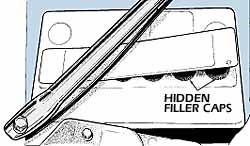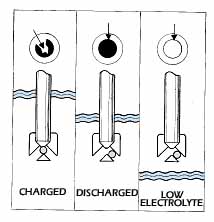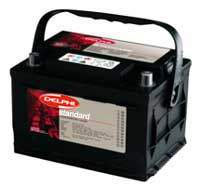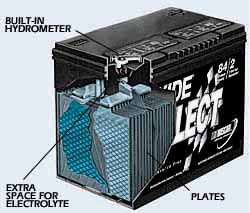Battery
Battery Coding
Most common batteries have a type number (UK) & this generally decides the physical size & the pole type/configuration but not the current rating as type numbers are available in several capacities eg 44A to around 70A.
The more modern numbering system is the ETN system.
eg 580-063-039
In which the 1st three digits are the current rating (-500) then the configuration & physical size (type number 063) & the last three are cold cranking (X100) so in this example the battery specs are: 80A - type063 - 390A cold cranking.
- Voltage - 12V
- Capacity - 55Ah
- CCA(EN) - 540A / 390A / 450A (but not important)
- Dimensions(mm): 242 x 175 x 175
Battery "Conditioning"
Please add Info
Like many things in life, the term “maintenance-free” is only partially true. Lead-acid batteries normally consume some of the water in their dilute sulfuric acid electrolyte during a normal charge-discharge cycle. It actually electrolyzes into hydrogen and oxygen and escapes as gas. So adding water periodically is necessary to keep the plates flooded. Maintenance-free batteries use a calcium alloy of lead instead of an antimony alloy, which reduces the amount of electrolysis. In addition, the amount of free-standing electrolyte above the plates is designed to be much higher in a new maintenance-free battery. This means that there’s enough electrolyte to keep the plates covered even after a few seasons of normal use. So, during the battery’s normal service life there should be no need to add water. Any abnormal electrical system condition or high ambient temperatures may boil off more than the normal amount of water, however. Adding water may extend the service life of these supposedly maintenance-free batteries, although one should be careful not to over dilute the electrolyte level.
The extended use of battery chargers or conditioners may also cause the electrolyte levels in the cells to be reduced. Indeed, some battery conditioners that are marketed as being suitable for permanent connection are not suited for this - they can also reduce the electrolyte level over time. This is because they deliver a constant, allbeit very low, current to the battery.
A truely intelligent conditioner should not have this problem, as they monitor the charge in the battery, adjusting the charge given to the battery as necessary. The Accumate is one such charger, although there are others that should be suitable.


Halfords
Code: Type 063
It is on their computer system if you cant remember and need to ask them. Also remember there is a SELOC discount for all members at Halfords - check the benefits pages for instructions.
They might offer to fit it, but after checking their computer they'll find a warning that they've had problems with Elise immobilisers, and then decline to fit it for you. Alledgedly their problem was with immobilisers on early S1's, but dont fear, just following the handbook procedure for S2's certainly produced no problems at all.
S1 Fitting
(Hopefully an S1 owner will be along shortly to confirm their handbook is fine too)
S2 K-series Fitting
The procedure is described in the Owners Handbook and is pretty self explanatory:
1. Undo the retaining clamp at the base of the battery (6mm allen key required), and slide the battery out of the retaining shoe so you have easy access to the terminals. If you're doing this on your own - loosen the negative black earth cable nut slightly BUT DONT DISCONNECT IT JUST YET.
2. Turn all lights, radios, satnav etc equipment off.
3. Turn the ignition off and wait about 10 seconds for the engine management system to settle down.
4. DONT arm the alarm or immoboliser
5. Within 25 seconds of turning off the ignition (ie before the immobiliser/alarm kicks in), disconnect the negative black earth cable from the battery.
6. Disconnect the positive red cable from the battery.
7. Swap the old battery out, transfer the terminal connectors to the new battery, put the new battery into the boot so you can work on it to reconnect the terminal cables.
8. Connect the positive red cable to the new battery.
9. Connect the negative black cable to the new battery (have the keyfob to hand just in case the alarm goes off)
10. Slide it back into the retaining shoe, refit the 6mm clamp.

